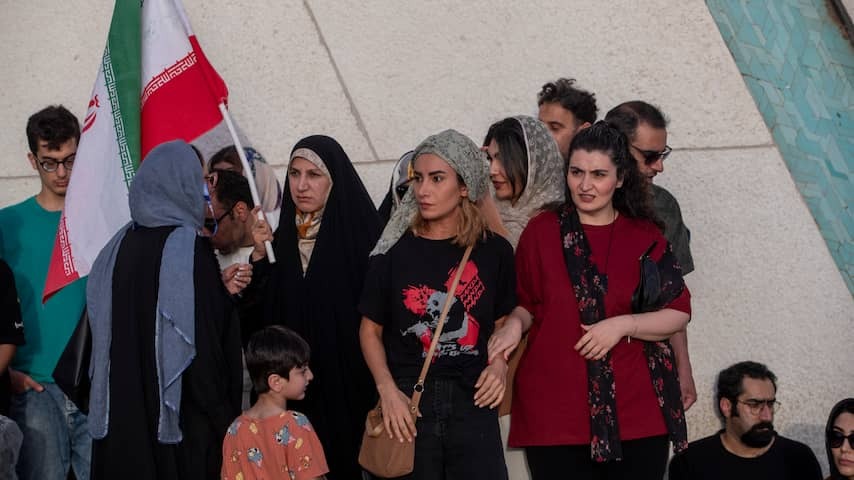
A portion of Iranians are disappointed that the Islamic regime is still standing after the Israeli and American attacks a week ago. They seem to be back to square one. But a regime change was not a serious option, experts tell NU.nl.
Farhad* has returned to Tehran a week after his flight from the capital. The 39-year-old coffee machine dealer left with his family shortly after the start of the Israeli attacks. They drove to the mountains north of Tehran in a crowded car. A journey that usually takes only four hours took them eleven. Along the way, they saw clogged roads and people fighting each other for gasoline.
But the Iranian is not relieved now that the attacks are over and he is back home. He had hoped that the Israeli and later American offensive would not only destroy nuclear installations but also topple the regime. Although the army suffered severe blows and there was even speculation about the killing of Ayatollah Khamenei, the end of the Islamic Republic does not seem in sight.
The possibility of such a regime change with the help of arch-enemy Israel was far from ideal. Yet, according to some Iranians, it was better than the status quo. “Finally, the regime got a kick in the ass,” Farhad tells NU.nl via WhatsApp. Of course, he was afraid that he would lose friends and family, he writes. “But any intervention is welcome.”
Why is the Islamic regime so unpopular among Iranians?
Since the ayatollah came to power in 1979 and Iran became an Islamic republic, the Iranian people have been oppressed. The right to free expression is restricted, and protest is often violently suppressed.
According to Human Rights Watch, “thousands of people are arbitrarily detained, interrogated or harassed” in Iran. There are also enforced disappearances and torture of political opponents. A morality police checks whether residents comply with Islamic dress codes.
The enemy of my enemy is my friend
Iran expert Peyman Jafari recognizes that sentiment among a section of the Iranian population. He talks about the principle whereby ‘the enemy of my enemy is seen as a friend’. “That group thinks: how nice that the person who attacked me is now being attacked himself.”
According to Jafari, that feeling prevailed especially at the start of the Israeli attack. When Israel also attacked hospitals and civilians, many Iranians quickly adjusted that position.
It is difficult to determine how many Iranians think that way. According to research, including by the University of Utrecht in 2023, 80 percent of Iranians want to get rid of the Islamic Republic. The group that would accept help from Israel is much smaller, Jafari emphasizes. “But it is a substantial minority of millions of people.”
Regime change was wishful thinking
Damon Golriz, strategic Iran analyst, also heard many Iranians who saw opportunities in the Israeli attacks. But at the same time, he calls the idea of a regime change “simplistic and wishful thinking“.
According to Golriz, the current rulers are doing everything they can to maintain their authority. And if the regime falls, that could lead to great chaos, he fears. “As an Arabic saying goes: a year of anarchy is worse than sixty years of tyranny.”
Jafari says that it is also easier said than done to “turn things around”. Right now, he sees how the Basij is recruiting en masse. That is a paramilitary militia that is loyal to the ayatollah. “They have the weapons. And anyone who rebels, in their eyes, is colluding with the enemy.”
The latter became clear in recent days. After the ceasefire, the authorities are looking for spies. 700 people have already been arrested on suspicion of spying for Israel, state media report. A number of them have been hanged.
Return of the Shah?
The Iranians who want to get rid of the ayatollah and his elite army, the Revolutionary Guard, no longer know who they can count on. Activists who have publicly spoken out against the regime are often in prison.
Some look abroad for bright spots. A name that is often mentioned is that of Reza Pahlavi. He is the son of the last Iranian Shah or ‘king’. He fled the country during the Islamic Revolution in 1979. That year, Ayatollah Khomeini returned to Iran after exile in Paris.
Many think that this could now happen in reverse, says Golriz. Pahlavi could then lead a democratic transition in Iran.
Jafari is not convinced that Pahlavi can deliver on that promise. “It is a resounding name,” he says, “but the man has not succeeded in setting up a large party that unites the so-called Iranian monarchists.” Another resistance movement operating from abroad is the People’s Mojahedin (MEK). According to Jafari, it is better organized, but not popular with a large part of the Iranian population.
Earlier resistance has repeatedly failed
At the moment, Farhad has little hope. He disagrees with the conviction that Iranians must resist without foreign aid. “We have already resisted the regime ourselves several times,” he says. “But that has failed every time.” Earlier demonstrations, such as those in 2009 and 2022, were suppressed, resulting in many deaths and injuries.
“I don’t see a rosy future for myself, at least not in the coming years,” Farhad concludes. “In a democratic society, you have people who are chosen to defend your interests. We have no one, only ourselves.”
*Farhad is a fictitious name. His real name is known to the editors.